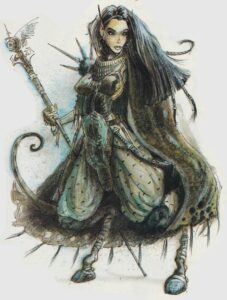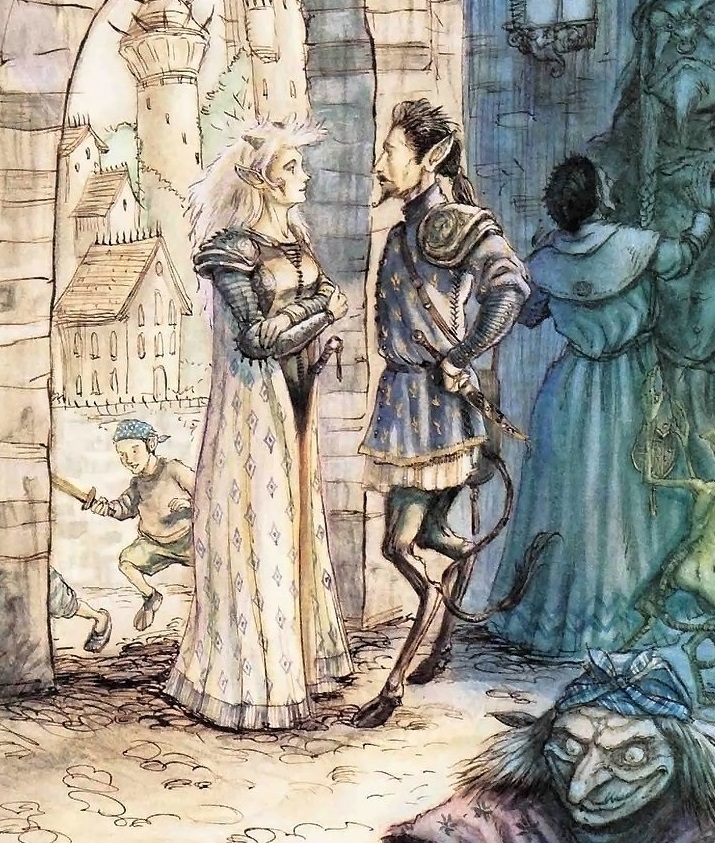Planescape creator David “Zeb” Cook and Colin McComb, lead designer of some of Planescape’s best products, kindly answered questions about Tieflings for my article The Evolution of Tieflings in Dungeons & Dragons. Here is the full transcript of their responses to my questions:
Q&A with David "Zeb" Cook, Planescape Campaign Setting creator
Q: In an interview with DND Beyond, Mike Mearls said that players like to play Tieflings in 5e because “you get to play the edgy, darker character,” and “If you like the idea of being the foreigner, someone who really stands out.” Did you have a similar design goal when creating the Planescape Campaign Setting?
 Zeb Cook: More or less. I created a couple of new races and definitely needed one that played on the fallen angel/reformed devil trope. It's a type of anti-hero who has always been popular in fantasy and was necessary in my opinion for Planescape. I didn't want it to be "oh, you're a junior demon" -- that would have been problematic in play for a number of reasons. At the same time I wanted them to be unable to hide their origin because that was such a defining part of their character. In the end, it was a blatant attempt to appeal to the goth/emo mindset -- plenty of opportunity for angst and drama but without giving them unbalancing power. Part of the role-play about them was the idea that you couldn't hide or escape the suspicions about your parentage, even if you were playing the most lawful/honest/good tiefling out there.
Zeb Cook: More or less. I created a couple of new races and definitely needed one that played on the fallen angel/reformed devil trope. It's a type of anti-hero who has always been popular in fantasy and was necessary in my opinion for Planescape. I didn't want it to be "oh, you're a junior demon" -- that would have been problematic in play for a number of reasons. At the same time I wanted them to be unable to hide their origin because that was such a defining part of their character. In the end, it was a blatant attempt to appeal to the goth/emo mindset -- plenty of opportunity for angst and drama but without giving them unbalancing power. Part of the role-play about them was the idea that you couldn't hide or escape the suspicions about your parentage, even if you were playing the most lawful/honest/good tiefling out there.
Q: Tieflings’ connections to the lower Planes started out broad and vague (plane-touched, part human and part something else) and with a lot of variety (especially all the options introduced in the Planewalker’s Handbook). Then in 4e and now in 5e, the lore was changed, to make them have Infernal ancestry and be the result of a pact with Asmodeus. Why did you initially choose to give them vague ancestry? And how do you view how Tieflings have changed through the editions?
Zeb Cook: I deliberately left it vague for two reasons. One, because that's not my job, as it were. I didn't want to constrain the player about how or what they imagined their character's past and parentage to be. To my mind, setting specific limits or definitions on what that "other" part of them is takes away from the mystery and makes their background a bit more of a rules mechanic as opposed to an RP opportunity. To say it was a pact or whatever removes so many other good possibilities -- that they were the result of doomed love between an infernal and a human or a love that defies both sides, that they are outcast by both sides, that their parentage was part of an infernal plot, that the player was an infernal's revenge on an arrogant noble, etc. A character could even be the manipulation of higher powers attempting to "humanize" their infernal foes.
Second, a vague background provided better defense against power gaming. Saying that somewhere back when your family got a touch of darkness makes it harder to argue that I should have X ability because that's what my great-grandpappy could do. I tend to dislike that kind of game approach because players start to make character picks to get rules advantages as opposed to role-playing a character.
So clearly, I liked that background vague. While there is nothing wrong with saying your character was the result of some ancient pact, I'd prefer that not every tiefling had to be defined that way.
Q: Among the many innovations Planescape added to D&D, Tieflings seem to be one of the ones with the most sticking power. They’re now one of the core races and more popular than other core races such as Halflings and Half-orcs. Why do you think Tieflings have had this kind of staying power?
Zeb Cook: I'm equally surprised and pleased that tieflings have hung around. While we all expected them to be popular within Planescape itself, I never anticipated that they would become part of mainstream D&D (I think Tony Diterlizzi's art helped in this!). At the time their home always seemed to be part of Planescape and they would be odd man out in the other settings -- tieflings in Forgotten Realms or Dragonlance just didn't mesh in. They were always "those things from Planescape" when you used them in other settings. Of course, one of the opportunities of each new edition is the chance to redefine what belongs and what doesn't, so I'm happy that tieflings made that cut.
As for why they have staying power, that doesn't seem very mysterious. The tiefling falls into a fantasy archetype -- the changeling, the trickster, the cursed hero/heroine -- that hadn't been represented in D&D's characters lineup to that point. D&D's roots were focused on the epic/high fantasy stereotypes (and there is nothing wrong with that) while the idea of the quasi-damned character is more a romantic/tragic/dark fantasy tradition. Therefore, they filled a gap in the choices for the player. Previously, a player could take a half-elf and work them into that role, but it took explanation to show how your backstory was different from the average half-elf and why you should be treated uniquely. With the tielfing you have the immediate identification with that theme which gives everyone at the table a shared assumption.
Q: Last question--any Yugoloth Tieflings out there, or are they all Tanar’ri or Baatezu?
Zeb Cook: Frankly, I don't know why there couldn't. They breed after all. The biology or magical chicanery of how this happens is best left unimagined -- which is another reason to keep ancestries vague.
Q&A with Colin McComb, Designer of Faces of Evil: The Fiends and Hellbound: The Blood War
Q: Tieflings got promoted in 4e and now 5e, becoming a core race in the PHB, and stats show they’re more popular than some of the traditional races such as gnomes, halflings, and half-orcs. This even as the Planescape setting itself still awaits a reboot. Do you have any thoughts on why Tieflings have resonated with players?
 Colin McComb: Tieflings resonate because they're dark and edgy. They've got an automatic built-in secret. They're outsiders and loners, and they have a good reason to shun society (and be shunned by it). They're a perfect stand-in for misunderstood youth. It's also possible that players are just ready to move beyond the strictures of normal high fantasy, and the lure of the planes is too strong for them to resist.
Colin McComb: Tieflings resonate because they're dark and edgy. They've got an automatic built-in secret. They're outsiders and loners, and they have a good reason to shun society (and be shunned by it). They're a perfect stand-in for misunderstood youth. It's also possible that players are just ready to move beyond the strictures of normal high fantasy, and the lure of the planes is too strong for them to resist.
Q: In 2e, was the idea that Tieflings were always the result of a physical union between a fiend and a human sometime in their ancestry (presumably creating a cambion/alu-fiend, then eventually a Tiefling)? Or could Tieflings be created in other ways, such as through pacts or rituals? In 5e, it looks like that’s not necessarily the case, as they are called “the result of a pact that infused the essence of Asmodeus into their bloodlines."
Colin McComb: Generally, they were supposed to be sexually derived, but remember that fiends *can* have a strange way of procreating. It's entirely possible that such a union could come about via dreams, via thoughts, or pacts/rituals. Such pacts might come with a *memory* of a sexual act, but this could be entirely symbolic of the fiend penetrating the victim's psychic defenses. But mostly, I think the intent was that they were the result of sexual procreation.
Q: Were Tieflings ever created from unions of Fiendish races besides Tanar’ri and Baatezu? In particular, did you ever imagine Tieflings descended from Yugoloths? Faces of Evil talks about Tanar’ri and Baatezu having children with mortals, but only talks about Yugoloths procreating with each other.
Colin McComb: Non-tanar'ri/baatezu tieflings would be vanishingly rare, but still possible. I did anticipate there might a rogue yugo-spawn here and there, or perhaps seeded with the blessing of an ultroloth, but they'd be extraordinarily rare. The 'loths tend to let the lesser fiends touch mortal flesh.
Q: In Faces of Evil, you wrote, “Tieflings can be of either gender, or none, or both. There’s a broad range of possibilities open to us, and we experiment whenever we can (a story for another time). Did you ever write that story, or flesh it out in your head, or was that another of Planescape’s many ambiguous points to spur imagination?
Colin McComb: The gender story was never written. As I recall, we had a discussion about it, but didn't actually write anything down. This was another case of "let's mention this, and maybe we'll get back to a full discussion about it in a later book"... one which, unfortunately, never got that full discussion.
